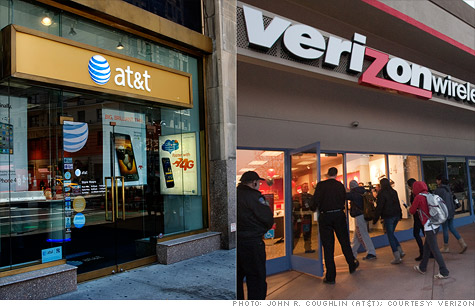 Cell phone customers are jumping between carriers more quickly than ever before. —
Cell phone customers are jumping between carriers more quickly than ever before. —
NEW YORK (CNNMoney) — The average cell phone customer now switches carriers as soon as his or her second two-year contract is up. That startling decline in loyalty is causing wireless companies to rethink the way they do business, according to a new study released Monday.
The average length of relationships between carriers and their under-contract customers fell to an all-time low of 48 months last year, PricewaterhouseCoopers’ found in the latest edition of its North American wireless industry survey. The comprehensive annual study includes data from all of the region’s major carriers.
The trend has building for a few years. What’s shocking is how quickly it accelerated. In 2010, the average customer-carrier relationship was 59 months — nearly a full year longer.
The most precipitous decline came among smaller cell phone companies, but large carriers like Verizon (VZ, Fortune 500), AT&T (T, Fortune 500) and Sprint (S, Fortune 500) didn’t fare much better. Their average relationships with customers under contract lasted just 51 months.
“Competition is fierce, and pricing is a key element,” said Pierre-Alain Sur, global communications industry leader at PwC. “That accelerates the jump from one carrier to another at the end of a contract period.”
If customers are going to cut and run frequently, carriers will need to rethink their pricing models — particularly when it comes to expensive smartphones.
They’ve been encouraging customers to upgrade to smartphones because the devices bring in a new revenue stream. Most providers charge smartphone customers a premium for data usage, with plans averaging about $25 per month.
But what carriers didn’t anticipate were the incredible costs of keeping smartphone customers satisfied.
To get smartphones down to the magic price point of $200, carriers pay an average subsidy of $280 for each device — four times as much as the $70 average subsidy on a feature phone. Plus, smartphone customers are data hogs, requiring wireless companies to spend tens of billions of dollars each year improving their 3G network capacity and building out their 4G networks.
Meanwhile, average revenue per smartphone user is actually declining.
As data use grows, people are talking on their phones less. The average subscriber used just 638 voice minutes per month in 2011, down from 720 minutes in 2010. Customers are cutting back their voice plans, sending carriers’ average revenue per smartphone user down to $83 per month last year. That’s a drop from $86 in 2010 and $93 from 2009.
Less loyalty, growing subsidies, higher infrastructure costs and declining revenues have created an unsustainable dynamic for carriers. Profit margins are falling, and analysts expect the trend to get worse.
The iPhone is a nightmare for carriers
That means sweeping changes are coming.
“The business model is shifting, so they have to find a solution,” Sur said.
Carriers have a few options.
First, they can increase prices on their phones. That’s already started to happen. Verizon and AT&T now offer a small selection of 4G phones for more than $200, with some as high as $300.
Another tactic is for them to pressure handset manufacturers to reduce device costs. Some may bargain, but the maker of the single most popular smartphone — Apple’s (AAPL, Fortune 500) iPhone — is no pushover.
Carriers could also try to find alternative sources of revenue. Right now, most are “dumb pipes,” taking no revenue from the content that travels over their networks. If carriers could nab a slice of app store sales or video purchases, that might reverse their fortunes.
Finally, cell phone companies could switch to the “bring your own device” model that is popular overseas.
North American carriers have embraced the subsidy model for decades for two reasons: incompatible technologies presented steep obstacles to switching, and the subsidy model seemed to build customer loyalty.
Now, the whole industry is migrating to the 4G-LTE standard. With loyalty going out the window, carriers may drop subsidies and contracts altogether. Some may even try leasing handsets to customers.
Whichever option carriers choose, they will have to act fast, Sur thinks.
“They are going to have to determine what’s going to be the business model of the future,” he said. “Carriers are at an inflection point.” ![]()
- Share


You must log in to post a comment.